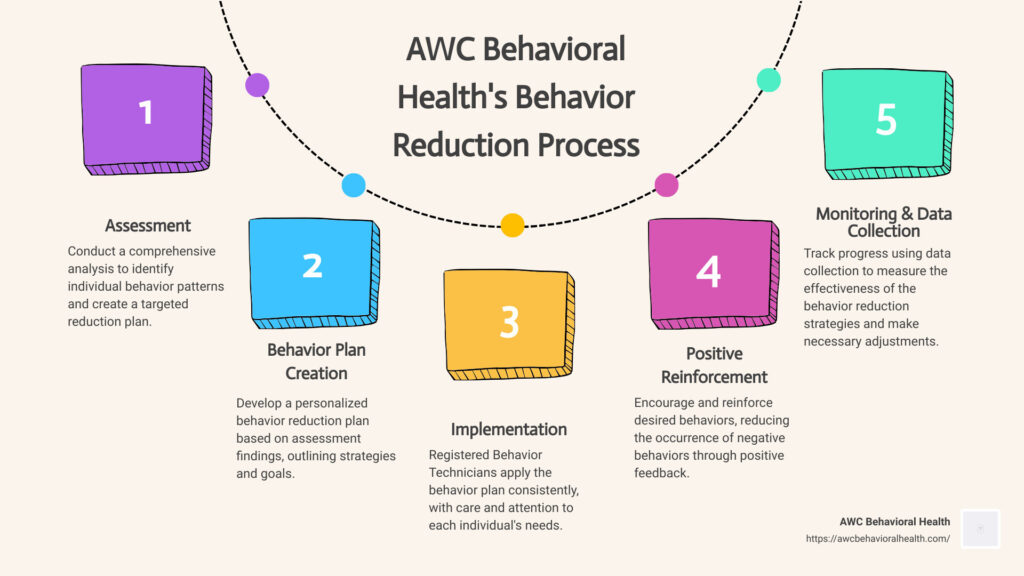Introduction to Behavior Reduction
Have you ever felt overwhelmed by challenging behaviors, whether it’s during a family meal or a public outing? At AWC Behavioral Health, we understand these challenges deeply. Our goal is to transform daily interactions through effective behavior reduction strategies. Behavior reduction, at its core, is about understanding and addressing behaviors that impede well-being and developing a plan to change them effectively.
Behavior Reduction Principles:
– Assessment: We start with a detailed analysis of the individual’s behavior to create a targeted reduction plan.
– Implementation: Our Registered Behavior Technicians carry out the plan with consistency and care.
– Positive Reinforcement: We focus on encouraging desired behaviors to naturally reduce undesired ones.
– Data-Driven: Progress is measured through meticulous data collection, ensuring our methods are working.
Behavior reduction isn’t just about eliminating a negative behavior; it’s a comprehensive approach that promotes the acquisition of new skills and enhances overall well-being. Through a personalized and evidence-based methodology, we aim to empower individuals and their families with the tools for lasting change.
Understanding the Concept of Behavior Reduction
What is Reductive Behavior?
Reductive behavior refers to the strategies employed to decrease the frequency or intensity of unwanted behaviors. Behavior reduction is a key component of therapeutic interventions for individuals, especially those with special needs. It’s not about suppressing a person’s natural tendencies but rather about fostering more positive and socially acceptable behaviors that can improve their daily life and interactions.
The Role of Applied Behavior Analysis (ABA) in Behavior Reduction
At AWC Behavioral Health, we utilize Applied Behavior Analysis (ABA) as a cornerstone of our behavior reduction services. ABA is a science-backed approach that focuses on the effects of the environment on behavior. It involves observing the relationships between behavior and the environment, identifying the purposes that behaviors serve, and applying interventions to promote positive behavior while reducing harmful or disruptive ones. Our aim is to create a supportive environment that encourages the acquisition of new skills and minimizes the need for reductive behavior.
The Difference Between ABA and Cognitive Behavioral Therapy (CBT)
While ABA and Cognitive Behavioral Therapy (CBT) are both highly effective in addressing various behaviors, they differ in their methods and focus. CBT is grounded in the interplay between thoughts, feelings, and behaviors. It works on the principle that by changing negative thought patterns and beliefs, we can affect emotional regulation and behavior. In contrast, ABA doesn’t typically address internal states like thoughts or feelings but rather focuses on observable behavior and how it’s influenced by the external environment.
By understanding these differences, caregivers can better select the therapy that matches their child’s unique needs, ensuring that they receive the most appropriate and effective support.
Behavior reduction is more than a set of techniques; it’s a pathway to enhancing life’s everyday moments, enabling smoother, more positive interactions for individuals with special needs.

The Process of Behavior Reduction
The Importance of Identifying the Function of Behavior
To effectively reduce negative behaviors, it’s crucial to understand why these behaviors occur in the first place. This is often referred to as identifying the function of behavior. In Applied Behavior Analysis (ABA), behaviors are seen as a form of communication, and through careful observation and assessment, we strive to understand what an individual is trying to convey. Is the behavior a means to gain attention, escape a task, acquire a tangible item, or is it self-stimulatory?
At AWC Behavioral Health, we begin with a thorough assessment to pinpoint the specific triggers and functions of the behavior in question. This allows us to create a personalized strategy that addresses the root cause rather than just the symptoms.
How Extinction Plays a Role in Behavior Reduction
After figuring out the purpose of a behavior, we may apply a method known as extinction. This technique involves not giving the reinforcement that used to fuel the behavior. As an illustration, if a child throws tantrums to gain more screen time, the extinction approach would mean not allowing extra screen time after tantrums. This approach can reduce the behavior over time. However, there’s a chance of an “extinction burst,” where the behavior might momentarily become more frequent or intense before it lessens. It’s essential to stay patient and consistent during this phase to effectively reduce the behavior.
The Use of Differential Reinforcement in Behavior Reduction
Differential reinforcement is a powerful tool in our behavior reduction arsenal. It involves reinforcing a desirable behavior while withholding reinforcement for an undesirable one. There are different types of differential reinforcement, such as reinforcing an alternative behavior (DRA) that serves the same function as the undesirable behavior or reinforcing the absence of the behavior over a period of time (DRO).
Implementing differential reinforcement requires precision and a good understanding of the individual’s needs. For instance, if a child tends to shout for attention, we would ignore the shouting (extinction) while praising or rewarding the child for using an appropriate volume (differential reinforcement). This encourages the child to use the positive behavior more frequently.
Implementing Behavior Reduction Strategies
Implementing behavior reduction strategies is a critical step towards improving the daily lives of individuals with special needs and their families. At AWC Behavioral Health, we are committed to providing the guidance and support necessary to make this process as effective and seamless as possible. Let’s explore how we create a Behavior Reduction Plan (BRP), ensure treatment integrity, and the vital role of Registered Behavior Technicians (RBTs) in this journey.
Creating a Behavior Reduction Plan
A Behavior Reduction Plan (BRP) is a comprehensive strategy designed by our Board-Certified Behavior Analysts (BCBAs) to address specific challenging behaviors. It’s like a roadmap that guides us on how to decrease unwanted behaviors while teaching and reinforcing positive, alternative behaviors.
Firstly, we start with a thorough assessment to understand the unique challenges and triggers of each individual. This assessment informs the development of the BRP, which outlines:
- Challenging behaviors with clear operational definitions so everyone knows exactly what we’re addressing.
- Hypothesized functions of these behaviors to understand why they occur.
- Antecedent interventions to prevent challenging behaviors before they start.
- Replacement behaviors that fulfill the same need as the challenging behavior, but in a more appropriate way.
- Reinforcement procedures to encourage the replacement behaviors.
Each plan is personalized and takes into account the preferences and needs of the individual. The success of a BRP hinges on its implementation. That’s where treatment integrity and the expertise of RBTs come in.

The Importance of Treatment Integrity in Implementing Behavior Reduction Strategies
Treatment integrity, or fidelity, is the assurance that the BRP is carried out exactly as it was designed. It’s the glue that holds the plan together. Without it, we can’t accurately measure the effectiveness of our strategies or make informed decisions about necessary adjustments.
There are several types of treatment integrity errors, such as:
- Consistency Errors: Not applying the intervention uniformly across all situations.
- Accuracy Errors: Missing steps or not following the plan to the letter.
- Errors of Omission: Skipping parts of the intervention.
- Errors of Commission: Adding elements that are not part of the original plan.
The Role of Registered Behavior Technicians (RBTs) in Implementing Behavior Reduction Strategies
Our RBTs are the frontline implementers of the BRPs. They are specially trained to apply ABA principles and techniques under the supervision of BCBAs. Their role is multifaceted:
- They provide direct support to individuals, teaching new skills and managing challenging behaviors.
- They collect data on behavior and intervention effectiveness.
- They ensure that treatment integrity is maintained at all times.
- They communicate with families and other stakeholders to provide updates and gather feedback.

RBTs are essential in bringing the BRP to life. They work diligently to ensure that every strategy is implemented with care, precision, and empathy, tailoring their approach to each individual’s needs.
By putting these pieces together—a well-crafted BRP, a commitment to treatment integrity, and the skilled hands of our RBTs—we set the stage for meaningful change. Through consistent and accurate implementation of behavior reduction strategies, everyday interactions can be transformed, leading to a more harmonious and fulfilling life for individuals with special needs and their families.
The Impact of Behavior Reduction Strategies on Daily Interactions
How Behavior Reduction Strategies Can Transform Daily Interactions
Behavior reduction strategies are powerful tools that can significantly improve daily interactions for individuals with special needs. When behavioral challenges are effectively managed, it opens the door to more positive experiences and opportunities for socialization. For example, a child who learns to replace aggressive behavior with a more appropriate form of communication may find it easier to make friends and participate in group activities.
At AWC Behavioral Health, we’ve seen firsthand how customizing interventions to an individual’s needs can lead to remarkable transformations. By addressing the specific behaviors that are barriers to successful interaction, we help individuals to engage more fully in life’s moments, from the classroom to the family dinner table.
The Importance of Setting Realistic Behavior Reduction Goals
Setting realistic goals is crucial in the journey of behavior reduction. It’s about acknowledging the individual’s starting point and recognizing that change is a process, not an overnight event. We help set goals that are attainable, which keeps motivation high and ensures that progress, no matter how small, is continually being made.
For instance, if a child is experiencing multiple tantrums a day, it would be unrealistic to expect no tantrums within a week. A more realistic goal might be to reduce the tantrums by half over a few months. This approach is not only more achievable but also less stressful for both the child and the caregivers.
The Use of De-escalation Techniques in Managing Behavior
De-escalation techniques are essential when it comes to managing behavior, especially when an individual is becoming agitated. These techniques involve identifying early signs of distress and employing strategies to calm the situation. This could mean changing the environment, using calming techniques, or redirecting attention to a more soothing activity.
At AWC Behavioral Health, we emphasize the importance of training for parents and caregivers in de-escalation methods. This empowers them to defuse situations before they escalate, leading to a safer and more controlled environment. By teaching individuals to recognize and manage their own signs of agitation, we are also helping them to build self-regulation skills that are vital for independence.
Behavior reduction strategies are not just about reducing negative behaviors, but also about enhancing an individual’s ability to navigate their world. By setting thoughtful goals and using de-escalation techniques, we can transform daily interactions into opportunities for growth and learning.
The Controversies Surrounding Behavior Reduction Strategies
Why Some People are Against ABA
When it comes to Behavior Reduction strategies, particularly those used in Applied Behavior Analysis (ABA), there’s a divide in public opinion. Some individuals argue that ABA can be incredibly helpful for children with autism, as it promotes communication and independence. However, there’s a growing voice of concern from those who believe that ABA can be detrimental because it may lead to the suppression of natural autistic behaviors. This group argues that ABA emphasizes conformity to neurotypical norms rather than valuing autistic traits, potentially impacting the child’s self-esteem and sense of identity.
Critics also point out that ABA, in its historical form, sometimes included aversive techniques, which could be harsh and are now widely considered unethical. They stress the importance of respecting the autonomy and individuality of people with autism, rather than solely focusing on making them “fit in.”
Addressing the Criticisms of Behavior Reduction Strategies
At AWC Behavioral Health, we are acutely aware of these concerns and take them very seriously. Our approach to ABA is modern, compassionate, and centered on the individual. We firmly believe in and practice the ethical application of ABA principles, which focuses on positive reinforcement rather than punishment.
Our goal is not to suppress who a person is but to help individuals learn new skills that can improve their quality of life and help them interact with the world more effectively. We prioritize the happiness and well-being of our clients, ensuring that any behavior reduction strategies we implement are in line with their needs and personal goals.
Moreover, we engage in continuous dialogue with the autism community, taking into account the views and experiences of those who have undergone ABA therapy. Through this open communication, we strive to evolve our practices to be as beneficial and respectful as possible.
In response to criticisms, we also emphasize transparency and collaboration. Parents and caregivers are integral to the therapy process, and we include them every step of the way. By doing so, we ensure that our strategies align with the family’s values and the individual’s personal growth, rather than an imposed standard.
Conclusion: The Transformative Power of Behavior Reduction Strategies
At AWC Behavioral Health, we believe in the transformative power of behavior reduction strategies. These strategies are more than just interventions for challenging behaviors; they are tools that can significantly enhance the quality of daily interactions for children with special needs and their families.
Positive Changes in Daily Life
When behavior reduction strategies are implemented effectively, the improvements can be seen in various aspects of daily life. From smoother transitions during daily routines to more enjoyable family outings, reducing negative behaviors can lead to a calmer and more predictable environment. This not only benefits the child but also reduces stress for the entire family.
Empowerment Through Support
We understand that the journey of managing challenging behaviors is not an easy one. That’s why we are here to offer support every step of the way. By empowering parents and caregivers with the right techniques and guidance, we foster a sense of confidence and competence. This empowerment can transform the way families approach daily challenges and celebrate successes.
Long-Term Benefits
The benefits of behavior reduction strategies extend well beyond immediate results. They can contribute to long-term developmental gains, improved social skills, and greater independence for children with special needs. By focusing on these long-term goals, we help pave the way for a more fulfilling and self-sufficient future for the individuals we serve.
Commitment to Excellence
Our commitment to you, as part of the AWC Behavioral Health family, is unwavering. We are dedicated to continuous improvement and staying abreast of the latest research to ensure that our behavior reduction strategies remain effective and ethical. Our goal is to create lasting positive change, and we are honored to be a part of your child’s growth and development.
For more information on how behavior reduction strategies can make a difference in your life, and to explore the services we provide, please visit our website. Our team is here to help you navigate the path to a more peaceful and rewarding life with your child.


